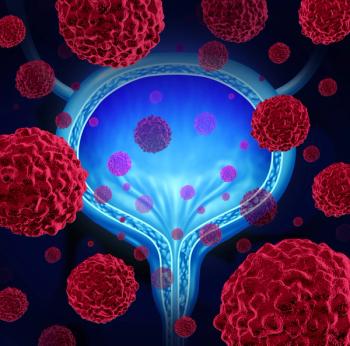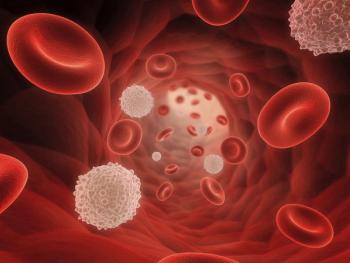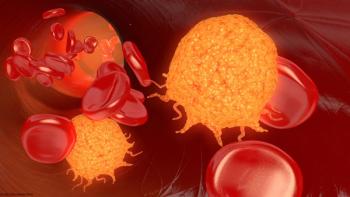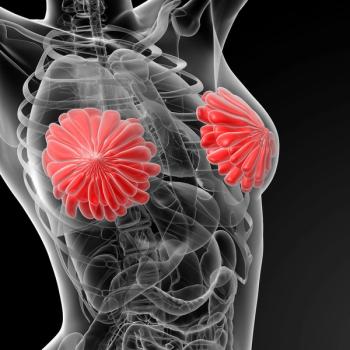
Raludotatug Deruxtecan Shows Promise in Platinum-Resistant Ovarian Cancer
Approximately half of the patients who received raludotatug deruxtecan in the phase 2/3 REJOICE-Ovarian01 trial achieved an objective response.
Findings from the phase 2/3 REJOICE-Ovarian01 trial (NCT06161025) highlighted a manageable safety profile and encouraging antitumor activity associated with raludotatug deruxtecan (R-DXd), an investigational antibody-drug conjugate (ADC), among those with platinum-resistant, high-grade serous or endometrioid ovarian, primary peritoneal, or fallopian tube cancer, according to a presentation at the
The data shared at ESMO, which were from the phase 2 part of the trial, showed that at a minimum follow-up of 18 weeks the objective response rate (ORR) in the overall study population was 50.5% (95% CI, 40.6%–60.3%), comprising a complete response rate of 2.8% and a partial response rate of 47.7%. The median time to response was 7.1 weeks (range, 5.1–19.1). The stable disease rate was 39.3%. Progressive disease occurred in 7.5% of patients.
The promising efficacy was observed across all 3 evaluated doses—4.8 mg/kg, 5.6 mg/kg, and 6.4 mg/kg. When also factoring in safety, as well as pharmacokinetic and exposure-response data, “5.6 mg/kg provided a positive benefit–risk profile and is considered the optimal dose” that will now be used in the phase 3 part of the REJOICE-Ovarian01 study, according to lead study author Isabelle L. Ray-Coquard, MD, PhD, Department of Medical Oncology, Centre Léon Bérard, Lyon, France.
What was the safety profile for R-DXd in the REJOICE-Ovarian01 trial?
At the data cutoff for the phase 2 trial, 61.7% of patients remained on study treatment. The median duration on study treatment was 5.5 months (range, 0.7–9.7) and the median relative dose intensity was 97.3% (range, 62.4%–108.0%). The reasons for discontinuing study treatment included progressive disease (24.3%), adverse events (6.5%), death (2.8%), and clinical progression (4.7%).
Overall, 93.5% of patients experienced any-grade treatment-related treatment-emergent adverse events (TEAEs), including 35.5% that were grade ≥3. There were no deaths associated with treatment-related TEAEs. Grade ≥3 treatment-related serious adverse events occurred in 10.3% of patients. Dose modifications linked to treatment-related TEAEs included treatment discontinuation (5.6%), dose reduction (18.7%) and dose delay (23.4%). Grade 3 and higher pneumonitis/interstitial lung disease considered to be related to treatment occurred in 1 patient.
What was the rationale and study design of the REJOICE-Ovarian01 trial?
Coquard explained that 65% to 85% of epithelial ovarian tumors express CDH6 and R-DXd is an ADC that targets CDH6.
The phase 2 part of the REJOICE-Ovarian01 trial examined R-DXd in 107 patients with platinum-resistant high-grade serous or high-grade endometrioid ovarian, primary peritoneal, or fallopian tube cancer.
Patients were randomized to receive R-DXd at 4.8 mg/kg (n = 36), 5.6 mg/kg (n = 36), or 6.4 mg/kg (n = 35) IV every 3 weeks. The primary end point was ORR by blinded independent central review.
What were the patient characteristics in the REJOICE-Ovarian01 trial?
The median patient age was 60 years (range, 34–81) and 15.9% of patients were aged over 70 years. Over half (57.0%) of patients were from Europe, 42.1% were from Asia, and 0.9% were from Australia. The ECOG performance status was 0 for 57% of patients and 1 for 43% of patients. Most patients (85.0%) had ovarian cancer, 3.7% had peritoneal cancer, and 11.2% had fallopian tube cancer. Tumor FIGO stages at initial diagnosis were I–II (10.3%), III (49.5%), IV (36.4%), and unknown (3.7%).
Regarding prior treatment, 51.4% had received more than 3 prior lines of systemic therapy, 39.3% had 2 prior lines, and 9.3% had 1 prior line. Among prior treatments received were bevacizumab (Avastin; 83.2%), PARP inhibitor (70.1%), and mirvetuximab soravtansine (Elahere; 2.8%). The last platinum-free interval was less than 3 months for 43.9% of patients and 3 to 6 months for 56.1% of patients.
At baseline, 94.1% of patients had any tumor CDH6 membrane positivity. Of these patients, 40.6% of patients were less than 75% positive and 59.4% of patients were 75% or higher positive.
What are the next steps with R-DXd?
The phase 3 part of the REJOICE-Ovarian01 study is now going to explore R-DXd at the optimal dose of 5.6 mg/kg vs physician’s choice of chemotherapy in patients with platinum-resistant ovarian cancer.
Of note, R-DXd was previously granted breakthrough therapy designation by the FDA for the treatment of adult patients with platinum-resistant epithelial ovarian, primary peritoneal or fallopian tube cancers expressing CDH6 who have received prior treatment with bevacizumab.2
References
- Ray-Coquard IL. Raludotatug deruxtecan (R-DXd) in patients (pts) with platinum-resistant ovarian cancer (PROC): primary analysis of the Phase 2 dose-optimization part of REJOICE-Ovarian01. Presented at: 2025 ESMO Congress; October 17-20, 2025; Berlin, Germany. Abstract LBA42.
- Raludotatug Deruxtecan Granted Breakthrough Therapy Designation by U.S. FDA for Patients with CDH6 Expressing Platinum-Resistant Ovarian, Primary Peritoneal, or Fallopian Tube Cancers Previously Treated with Bevacizumab. Published online September 15, 2025. Accessed October 19, 2025. https://tinyurl.com/53k39pcw
Newsletter
Stay up to date on recent advances in the multidisciplinary approach to cancer.

















































































